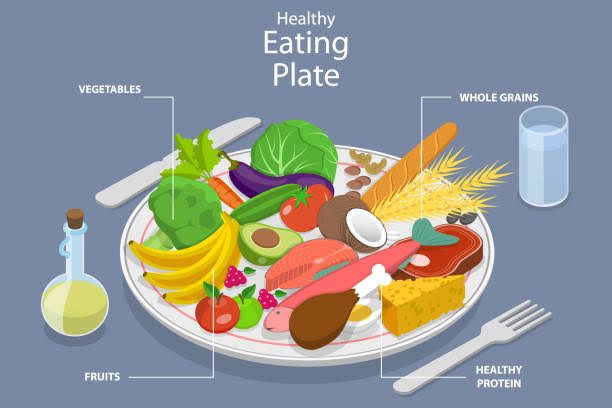- Empty cart.
- Continue Shopping
Mastering Portion Control: The Key to Your Weight Loss Journey

At Nutriosa, we believe that fitness is 80% what you eat and 20% what you do. Even the most rigorous workout routine can fall short if your eating habits are not aligned with your fitness goals. This is particularly true for weight loss, where managing your calorie intake is crucial. This is where portion control comes into play. Let’s explore this vital concept and how it can help you achieve your health and fitness aspirations.
What Is Portion Control?
Portion control is the mindful practice of consuming the right amount of food during each meal. It’s about understanding how much your body needs rather than piling on excess servings. This approach is not about deprivation but about balancing your plate in a way that aligns with your nutritional needs. It’s the cornerstone of eating smarter, not less.
What Does an Ideal Food Portion Look Like?
To practice portion control effectively, it’s essential to understand what constitutes an accurate food portion. According to dietary guidelines, here’s a general breakdown:
- Proteins: Aim to consume protein in grams equivalent to your body weight in kilograms. For instance, if you weigh 70 kg, target 70 grams of protein daily. To help reach your protein goals effortlessly, consider Nutriosa’s protein bar with 20 grams of protein per serving.
- Carbohydrates: Keep the portion of carbs slightly smaller than your protein intake.
- Vegetables and Fiber: These should make up half of your plate, offering essential nutrients and keeping you full.
- Fats: A small bowl or your closed fist is an excellent visual guide for healthy fat portions.
To fine-tune your portions:
- Define your fitness goal.
- Calculate your daily calorie requirement.
- Divide those calories into macronutrient categories (proteins, carbs, fats).
- Use tools like food scales or apps to ensure precision.
Portion Control and Its Role in Weight Loss
The relationship between portion control and weight loss is straightforward yet profound. By managing portion sizes, you can avoid overeating and maintain a calorie deficit, which is crucial for shedding extra pounds.
Here’s how to get started:
- Use smaller plates to make your portions appear larger.
- Limit calorie-rich snacks and avoid indulging in excessive cravings.
- Walk or engage in light activity between meals to curb unnecessary hunger.
- Stock up on healthy, low-calorie snacks to stay on track. Keeping a Nutriosa protein bar handy can be a great way to curb hunger while maintaining portion control.
Maximizing Portion Control for Weight Loss
To leverage portion control effectively, follow these simple yet impactful strategies:
- Avoid Sugary Beverages: Replace sugar in your morning tea or coffee with healthier alternatives or skip it altogether.
- Reduce Carbs: Begin by cutting down the serving size of rice, bread, or other starchy foods. Gradually, you may find yourself less tempted to reach for second helpings.
- Read Food Labels: Many packaged foods marketed as healthy can be high in hidden sugars or carbs. Always check the labels to stay informed.
- Snack Mindfully: Eat snacks only when genuinely hungry, not out of boredom or habit.
- Eat Slowly: Taking your time to eat allows your body to signal fullness, reducing the risk of overeating.
Building a Portion-Control Diet Plan
Portion control isn’t about eliminating your favorite foods but managing their quantities. Here are practical steps to create a balanced plate:
- Plan Ahead: Prepare your meals with portions in mind.
- Visualize Your Plate: Divide your plate into sections for carbs, proteins, and vegetables. Ensure vegetables occupy the largest section.
- Adjust Serving Sizes: Double the portion of protein-rich foods like lentils (daal) and reduce carb-heavy items like rice or bread.
- Carry Healthy Snacks: Keep portion-controlled snacks handy to avoid overeating during cravings.
Portion Control Diet Plan for Women
Women often have different nutritional requirements than men due to hormonal and metabolic factors. A portion control diet plan can ensure they get the necessary nutrients while supporting weight loss.
Here’s a sample plan:
- Breakfast: A slice of whole-grain toast with a spinach-and-egg omelette or a tofu scramble.
- Snack: A handful of nuts, a fruit, a Nutriosa protein bar, or a cup of yogurt with berries.
- Lunch: A serving of chicken curry or lentils (daal) paired with quinoa or brown rice.
- Dinner: Grilled fish or paneer cubes with a large serving of roasted or steamed vegetables.
Creating a Diet Plate for Weight Loss
- A well-balanced diet plate can make portion control simple:
- Half the plate should be filled with vegetables or salads.
- A quarter should contain lean proteins like chicken, tofu, or eggs.
- The remaining quarter should include whole grains or complex carbs such as brown rice or whole wheat roti.
- Add a small serving of healthy fats, such as olive oil or a dollop of ghee.
The Takeaway
Portion control isn’t about starving yourself; it’s about eating in alignment with your body’s needs. By optimizing your servings and making thoughtful food choices, you can fuel your body effectively and make steady progress toward your fitness goals.
Whether you’re looking to lose weight or maintain a healthy lifestyle, portion control can be your game changer. Combine this practice with balanced diet plans, exercise, and consistency to see transformative results.
Remember, small changes can lead to significant outcomes. Start with portion control today, and watch yourself move closer to your health goals with each meal!
